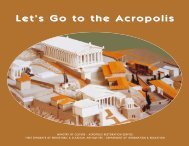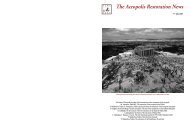τεύχος περιλήψεων - ΥΣΜΑ
τεύχος περιλήψεων - ΥΣΜΑ
τεύχος περιλήψεων - ΥΣΜΑ
Create successful ePaper yourself
Turn your PDF publications into a flip-book with our unique Google optimized e-Paper software.
6TH INTERNATIONAL MEETING FOR THE RESTORATION OF THE ACROPOLIS MONUMENTS - ABSTRACTS 29<br />
CONSERVATION INTERVENTIONS ON THE SURFACE OF THE ACROPOLIS MONUMENTS<br />
CONSERVATION RESEARCH ISSUES<br />
E. Aggelakopoulou, Chemical Engineer, Ph.D, NTUA. Head of the Surface Conservation Office<br />
and Worksite YSMA<br />
In the period 2000-2012 surface conservation work was performed on the Parthenon, the Propylaia,<br />
the Erechtheion and the Temple of Athena Nike. Systematic conservation interventions<br />
made on the Acropolis monuments pertain to surface consolidation, surface cleaning, restoration<br />
mortars and grouting. At the same time, documentation research issues emerged as well as<br />
research issues pertaining to the selection, design and implementation of appropriate materials<br />
and conservation interventions.<br />
For the development of a safe method for marbles surface cleaning from air pollutants, a research<br />
study was conducted on the comparative evaluation of different methods of cleaning (microblasting,<br />
gypsum inversion, absorptive poultices, laser), which resulted in the proposal for the<br />
implementation of a laser system. The laser was designed and developed by IESL-FORTH and it was<br />
used on the west frieze of the Parthenon and on the coffered ceiling of the Caryatids Porch of the<br />
Erechtheion.<br />
For the biodeterioration control there was a collaborative research with the Department of Biology<br />
of the University of Athens, the outcome of which was the identification of the characteristic<br />
types of micro-organisms responsible for the erosion on the monuments of the Acropolis.<br />
The effectiveness of various biocide materials was evaluated and the most suitable ones were<br />
proposed. The approval of the application of biocides is underway.<br />
The need to design appropriate joining mortars for piecing together the scattered adjoining<br />
sandstone architectural members of the archaic buildings of the Acropolis arose within the context<br />
of the project for the Scattered Architectural Memberships of the Acropolis Restoration Service<br />
(YSMA). For the mortar design, a research programme was carried out in collaboration with the<br />
Technical University of Crete, which resulted in the application of a joining mortar containing<br />
lime, metakaolin, calcareous aggregates and nano-titania. So far, 77 adjoining fragments have<br />
been joined together.<br />
In the context of the continuous improvement of the materials used in conservation interventions,<br />
compositions of restoration mortars (for sealing and filling) based on lime, hydraulic<br />
lime, metakaolin, white cement and calcareous or quartz aggregates were designed and subjected<br />
to physico-mechanical evaluation. This work is in progress.<br />
The technical investigation of the polychromy of the monuments was also a research issue<br />
and has been conducted so far in the coffered ceiling of the Erechtheion and on selected members<br />
of the Parthenon. This goal was achieved by modern imaging techniques which were applied<br />
in combination with non-destructive techniques in situ and with analytical techniques in<br />
the laboratory.<br />
In the context of the documentation of the original material, the characterization of historical<br />
mortars from the south wall of the Acropolis, the south wing and the Justinian cistern of the Propylaia<br />
was performed (Department of Chemical Engineering, NTUA).<br />
Research issues prioritized for future study are the surface consolidation of Pentelic marble<br />
and sandstone as well as the surface protection of Pentelic marble.








